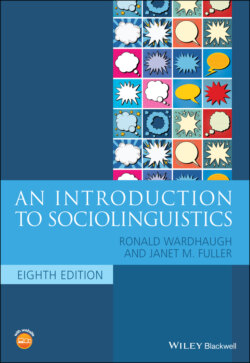Читать книгу An Introduction to Sociolinguistics - Ronald Wardhaugh, Janet M. Fuller - Страница 68
Shared norms
ОглавлениеOne approach to defining a speech community often taken in sociolinguistics is to say that the language users in such a community share some kind of common feeling about linguistic behavior in that community, that is, they observe certain linguistic norms. Such an appeal to norms is an essential part of Labov’s definition of speech community (1972, 120–121):
The speech community is not defined by any marked agreement in the use of language elements, so much as by participation in a set of shared norms; these norms may be observed in overt types of evaluative behavior, and by the uniformity of abstract patterns of variation which are invariant in respect to particular levels of usage.
This definition shifts the emphasis away from members of a speech community speaking the same to ascribing the same social meanings to particular ways of speaking. Milroy (1987, 13) has indicated some consequences of such a view:
Thus, all New York speakers from the highest to lowest status are said to constitute a single speech community because, for example, they agree in viewing presence of post vocalic [r] as prestigious. They also agree on the social value of a large number of other linguistic elements. Southern British English speakers cannot be said to belong to the same speech community as New Yorkers, since they do not attach the same social meanings to, for example, (r): on the contrary, the highest prestige accent in Southern England (RP) is non‐rhotic. Yet, the Southern British speech community may be said to be united by a common evaluation of the variable (h); h‐dropping is stigmatized in Southern England … but is irrelevant in New York City or, for that matter, in Glasgow or Belfast.
Thus it is not so much how one speaks as how one evaluates ways of speaking that forms a speech community according to this definition. For the purpose of research, however, this is not a practical definition; values of particular ways of speaking are even less immediately apparent than linguistic patterns. Thus while this idea about shared norms is an important one, it does not easily lead to clearly demarcated speech communities.
